Notes: Alne station opened in 1841, when the Easingwold Railway opened in 1891 a bay platform was provided at the northern end of the 'up' platform at Alne. A water column was located on the platform, but this was removed during the 1930's. The Easingwold's Alne Junction also included a passing loop and long siding. The NER had a small goods yard on the opposite side of Alne Station. A crossover allowed Easingwold locomotives to reach this yard, although the crossover was moved during a re-modeling in the 1930's.
Alne closed to passengers on 5th May 1958 a few month before complete closure of the Easingwold line. The station remained open for freight traffic until 10th August 1964 and the site was cleared during modernisation of the main line.
BRIEF HISTORY OF THE EASINGWOLD RAILWAY
Easingwold is a prosperous market town set in the agricultural area of the Vale of York. A station for the town was first proposed in 1836, followed by several other proposals. Nothing was successful until 1880, when a consortium of leading local farmers and merchants proposed a branch line to the town from Alne on the London - Edinburgh main line. Until the |
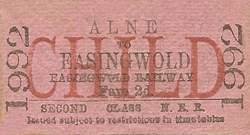 |
railway came, a horse-drawn carrier’s cart made the journey to Alne station three times a day. The consortium formed the Easingwold Railway Company which was incorporated on 27 August 1887. Prior to its construction, the company anticipated the passing of the Light Railways Act but this wasn't passed until 5 years after the line opened. The line therefore acted as a precursor to the act; it was built as a standard gauge light railway with rails spiked directly to the sleepers
.
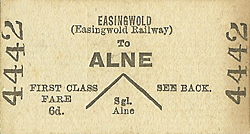 |
The Board of Trade inspectors described the line as "more or less a tram road" and restricted its speed to 12mph. The 2 1/2 branch running from a bay platform at Alne was opened on 27th July 27 1891 with free rides for children on the opening day. The line had cost about £17,000 to construct, £5,000 over budget. The company later applied for Light Railway |
Orders in 1896, 1912 and 1921, all of which were granted.
The station had a single platform with a small timber building; there was also an extensive goods yard comprising four sidings, passing loop, goods sheds, weighbridge, weigh office, coal drops, cattle dock and an engine shed large enough for the one loco owned by the company but no large enough for the locos later hired from the LNER and BR! |
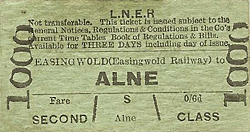 |
During the early years of the20th century, the line was never a great financial success but was just able to cover running costs but this wasn't sufficient to pay a dividend. Gradually this situation improved and by 1910, company accounts show a clear profit of £767 and a dividend of 4% was paid with 3-4% being paid annually for a number of years.
| Before the First World War there were nine trains in each direction on weekdays but the line never had a Sunday service. On Saturday night an additional train used to leave Alne for Easingwold at 11.20 p.m., having made connection with a railcar from York. During this period the company had a staff of twelve, made up of one stationmaster, one clerk, four porters, |
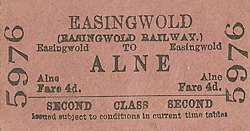 |
two drivers, one fireman, one guard, and two permanent way men.
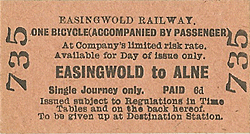 |
The company remained independent through the 1923 grouping and by the start of WW2 there were still seven daily trains. Freight traffic was mainly agricultural and was always more important than passenger revenue allowing the line to remain in profit until the 1920's but the end of the decade the company was finding it difficult to compete with road transport with |
only a 1% dividend being paid in 1931. Freight revenue improved during WW2 when it carried thousands of tons of war materials to be handled in the station yard until it was pointed out that it was unsafe to carry heavy loads of munitions over the old track with the risk of derailment and consequent explosion. In 1944 the new source of income from war supplies was ploughed back into the company by relaying the track with second-hand L.N.E.R. materials. The company was criticised at the time for not paying a dividend while the line was in profit.
| Following the end of the war, passenger numbers declined rapidly. The line remained independent after nationalisation but it was soon clear the company couldn't maintain a passenger service with passenger trains now reduced to two per day. In 1947 one first class passenger was carried, who paid 8d. and 635 second class passengers were carried paying a total of |
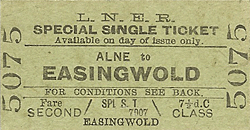 |
£18. Of these, only 231 passengers originated on the company’s system. The branch was clearly an early candidate for closure and passenger services were withdrawn on 29th November 1948, but the station remained open for freight with two freight trains every weekday except Saturday, when there is only one. On Friday, 28th September 28 1951, the Easingwold Railway ran a special train for the York Miniature Railway Society, the first passengers to use the line since closure 1948, a number of enthusiasts specials used the line through the 1950's.
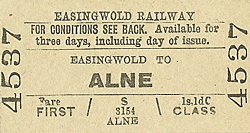 |
Running costs trebled between 1949 - 1956 and income declined by 28% and by the end of 1956 the line was losing £1,700 a year. The line closed on 27th December 1957 when the company went into voluntary liquidation with debts of £17,000. Within two years Alne Station was closed and demolished during the main line modernisation. Easingwold station |
survived until 1967 when it was destroyed by fire leaving only the Station Hotel standing. The site of the station has now been redeveloped as a road and housing.
| During its short life there were no through trains on "T'Awd Coffeepot" as the line was affectionately known locally and passengers had to rebook at Alne, unless they had booked to one of the twelve principal stations to which tickets were issued at Easingwold, chief of which were Harrogate, Leeds, Scarborough, Stockton and York. Parcels and goods traffic was |
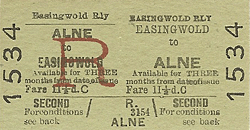 |
however, normally consigned through to its final destinations. The line was often referred to as England’s shortest standard gauge passenger railway at just 2 1/2 miles in length. Easingwold Council has retained a small stretch of the branch line between Drovers Court and Station Court as a park.
Sources: Railway Magazine April 1954, Lost Railways of North & East Yorkshire by Gordon Suggitt - Countryside books 2005 ISBN 1 85306 918 3 and the London & North Eastern Railway (Encyclopedia) web site. Tickets from Michael Stewart
See also Easingwold Station
See other ECML stations :Longhougthton, Lesbury, Warkworth, Longhirst, Morpeth, Stannington, Plessey, Annitsford (1st), Annitsford (2nd), Killingworth, Forest Hall, Heaton (2nd), Heaton (1st), Durham, Croft Spa, Otterington & Tollerton |

old1.jpg)










old2.jpg)
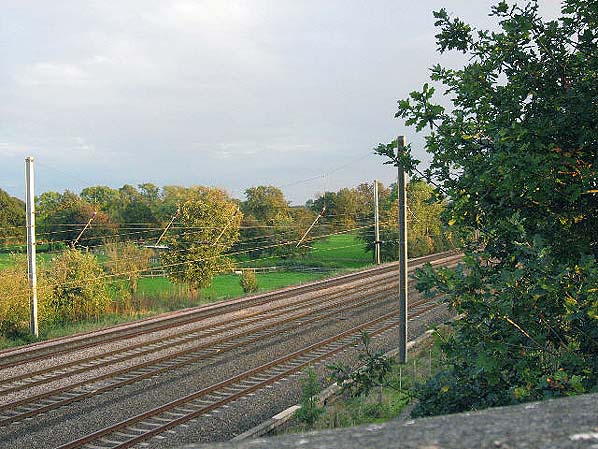

 Home Page
Home Page